The Department of History of Art & Architecture invites you to the 2025-2026 HAA Guest Lecture Series
Sponsored by the Boston University Center for the Humanities, the HAA Guest Lecture Series brings together historians of art and architecture specializing in diverse fields and genres. Prominent scholars and museum professionals are invited to share their latest work with the BU community in a lecture followed by a Q&A.
The 2025/2026 HAA Guest Lecture Series is organized by graduate students: Rachel Kline & Isaline Lefrançois
Be sure to follow the official department accounts on Facebook and Instagram to stay up to date on all the exciting HAA news and events.
Consider signing up to receive the HAA Email Brief, as well!
Upcoming Lecture
 Thursday, October 23rd at 6:00 PM in CAS 132
Thursday, October 23rd at 6:00 PM in CAS 132
Dr. Gregory Bryda
Assitant Professor of Art History, Barnard College
Title:“Higher Ground: Medieval Foundations and the Formation of Heathen Prehistory”
This talk argues that in the Middle Ages, Christians used art to exaggerate a pagan affinity with the land to invent a false contrast, which enabled a redefinition of the landscape through a Christian lens. From the eleventh to the fifteenth centuries, as Christianity spread eastward across northern Europe in successive waves, artworks in wood sculpture, monumental stone carving, manuscript illumination, panel painting, and woodcut consistently portrayed non-Christian peoples as nature-bound idolaters—tree-worshippers, grove-dwellers, keepers of wells and stones. Scholars have long mined these representations for traces of authentic pagan ritual, frequently construing them as proof of syncretism in the process of conversion. I contend that the artworks portray retrospective fictions. Produced after Christianity had taken root, these works were directed less at pagans than at other Christians. By portraying a primitive “other” bound to earth and nature, ecclesiastical communities of various stripes—parish churches, cathedral chapters, Cistercian monks, Teutonic Order knights—cast themselves as its opposite: orthodox, rational, divinely sanctioned. In doing so, they justified their authority, sharpened rivalries, and claimed stewardship over the land as a sacred trust. What has been read as proof of confrontation thus emerges instead as self-reflective, with patrons deploying the arts to reshape both the perception and the use of land to align with their own specific needs.
Archive of Past Lectures
2024-2025
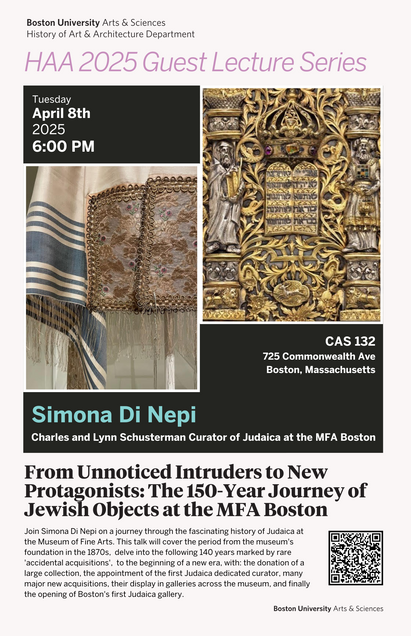 Tuesday, April 8th at 6:00 PM in CAS 132
Tuesday, April 8th at 6:00 PM in CAS 132
Simona Di Nepi
Charles and Lynn Schusterman Curator of Judaica at the MFA Boston
Title:“From Unnoticed Intruders to New Protagonists: The 150-year Journey of Jewish Objects at the MFA Boston”
Sponsored by the Boston University Center for the Humanities
 Thursday, September 19th, at 6:00pm – CAS 132
Thursday, September 19th, at 6:00pm – CAS 132
Dr. Nadya Bair
Assistant Professor of Art History at Hamilton College
Title: “Made for Distribution: Robert Capa and John Steinbeck’s Visit to the USSR, 1947.”
Sponsored by the Boston University Center for the Humanities
 Thursday, October 17th, at 6:30pm – CAS 132
Thursday, October 17th, at 6:30pm – CAS 132
Dr. Jennifer Le Zotte
Associate Professor of History and Material Culture at the University of North Carolina Wilmington
Title: “From Mother Hubbards to Feather Boas: Dressing Up Sex Work in Storyville.”
Sponsored by the Boston University Center for the Humanities
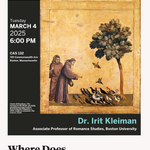 Tuesday, March 4th, at 6:00pm – CAS 132
Tuesday, March 4th, at 6:00pm – CAS 132
Dr. Irit Kleiman
Associate Professor of Romance Studies, Boston University
Title:“Where Does Transgression Begin?”
Sponsored by the Boston University Center for the Humanities
2023-2024
 Wednesday, November 8th, at 6:30pm – CAS 211
Wednesday, November 8th, at 6:30pm – CAS 211
Dr. Jennifer Van Horn
Associate Professor of Art History and History at the University of Delaware
Title:“Flora’s Profile: Enslavement, Resistance, and Haptic Memory”
Sponsored by the Boston University Center for the Humanities
 Tuesday, October 10th, at 6:00pm – CAS 211
Tuesday, October 10th, at 6:00pm – CAS 211
Professor Zeynep Çelik Alexander
Associate Professor of Art History and Archaeology at Columbia University
Title: “Paper Beats Rock: The Imperial Institute’s Media.”
Sponsored by the Boston University Center for the Humanities
2022-2023
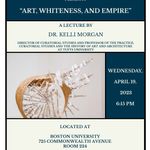 Wednesday, April 19, 2023, 6:15pm – CAS 224
Wednesday, April 19, 2023, 6:15pm – CAS 224
Dr. Kelli Morgan
Director of Curatorial Studies and Professor of the Practice, Curatorial Studies and the History of Art & Architecture at Tufts University
Title: “Art, Whiteness, and Empire”
Sponsored by the Boston University Center for the Humanities
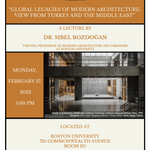 Monday, February 27, 2023, 5:00pm – CAS 211
Monday, February 27, 2023, 5:00pm – CAS 211
Dr. Sibel Bozdoǧan
Visiting Professor of Modern Architecture and Urbanism at Boston University
Title: “Global Legacies of Modern Architecture: View from Turkey and the Middle East.”
Sponsored by the Boston University Center for the Humanities
 Thursday, December 1st, 6:15pm – CAS 211
Thursday, December 1st, 6:15pm – CAS 211
Dr. Aaron Hyman
Assistant Professor of the History of Art at Johns Hopkins University
Title: “Rubens’s Wastepaper and the Eloquence of Substrate”
Sponsored by the Boston University Center for the Humanities
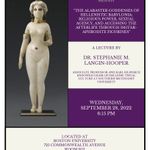 Wednesday, September 28, 2022, 6:15pm – CAS B12
Wednesday, September 28, 2022, 6:15pm – CAS B12
Dr. Stephanie Langin-Hooper
Associate Professor and Karl Kilinski II Endowed Chair of Hellenic Visual Culture at Southern Methodist University
Title: “The Alabaster Goddesses of Hellenistic Babylonia: Religious Power, Sexual Agency, and Accessing the Afterlife through Ishtar-Aphrodite Figurines.”
Sponsored by the Boston University Center for the Humanities
2021-2022
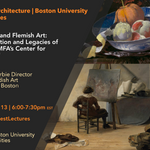 Wednesday, October 13, 2021, 6:00PM – via Zoom
Wednesday, October 13, 2021, 6:00PM – via ZoomChristopher Atkins, Van Otterloo-Weatherbie Director of the Center for Netherlandish Art
Title: “Reframing Dutch and Flemish Art at the MFA’s Center for Netherlandish Art: Issues of Globalization and Legacies of Capitalism”
Sponsored by the Boston University Center for the Humanities
 Wednesday, December 1, 2021, 6:00PM – via Zoom
Wednesday, December 1, 2021, 6:00PM – via Zoom
Deborah Kahn, Associate Professor of Art & Architecture, Boston University
Title: “Justifying Persecution, Promoting Conformity and the Revitalization of European Sculpture at the First Millennium”
Sponsored by the Boston University Center for the Humanities
 Wednesday, January 26, 2022, 6:00PM – via Zoom
Wednesday, January 26, 2022, 6:00PM – via Zoom
Professor John Ott, Ray and Margaret Horowitz Visiting Professor in American Art
Title: “A Handsome Differentiation of the Races”: New Deal Murals Imagine Integration
Sponsored by the Boston University Center for the Humanities
Wednesday, April 13, 2022, 6:00PM – via Zoom
 Professor Michelle Apotsos, Associate Professor, Williams College
Professor Michelle Apotsos, Associate Professor, Williams College
Title: “Islamic Spaces and the Muslims on the Margins in Contemporary South Africa”
Sponsored by the Boston University Center for the Humanities
2020-2021
Wednesday, October 7, 2020, 5:30PM – Via Zoom
Alice T. Friedman, Grace Slack McNeil Professor of American Art, Wellesley College
Title:”Poker Faces/Private Spaces: Modernism and the Languages of Architecture”
Sponsored by the Boston University Center for the Humanities
Wednesday, November 4, 2020, 6:00PM – Via Zoom
Charmaine Nelson, Professor of Art History and Communication Studies, McGill University
Title: “‘He… has the ends of both his great toes frozen off’: Enslaved and Free Black Presence, Experience, and Representation in the Quebec Winter”
Sponsored by the Boston University Center for the Humanities
Wednesday, February 17, 2021, 6:00PM – Via Zoom
David Joselit, Professor of Art, Film, and Visual Studies, Harvard University
Topic: “Curated Cultures”
Sponsored by the Boston University Center for the Humanities
Thursday, April 29, 2021, 6:00PM – Via Zoom
Jessica Horton, Associate Professor of Native American, Modern, and Contemporary Art, University of Delaware
Title:”Weavers, Earth Mothers, and Diplomats””
Sponsored by the Boston University Center for the Humanities
2019-2020
Title:”Black in the Garden: Ecologies of Art, Race, and the Outdoors.”
co-sponsored by the African-American Studies Program and the American and New England Studies Program
Wednesday, December 4,
Dana Leibsohn, Alice Pratt Brown Professor of Art; Director of Latin American and Latino/a Studies, Smith College
Title: “Inheriting the Pacific: Can Art History Think an Ocean?”
Title: “Emperor Taishō, Mass Media Monarch: Portraits and Popular Imagery in Twentieth-Century Japan”
2018-2019
Co-sponsored with the BU Initiative on Cities.
February 6th, Prof. Jodi Cranston, Boston University
Title: “Floating Arcadia: Pastoral Views of Renaissance Venice”
2017-2018

Tuesday, November 14, 2017, 6:00PM
Title: “Object Lessons: Synchronizing Modernity at MoMA”
Location: 725 Commonwealth Ave., Room 200
Wednesday, November 29, 2017, 5:30PM
Title: TBA
Location: 725 Commonwealth Ave., Room 200
2016-2017

Tuesday, September 20, 2016, 5:30 pm
Dr. Daniel Abramson, Boston University
“Representing the Welfare State”
Location: 725 Commonwealth Ave., Room 303A
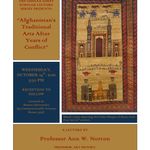
Wednesday, October 19th, 2016, 5:30 pm
Dr. Ann W. Norton, Providence College
“Afghanistan’s Tradition Arts After Years of Conflict”
Location: 725 Commonwealth Ave., Room 303A
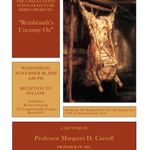
Wednesday, November 30th, 2016, 5:30 pm
Dr. Margaret Carroll, Wellesley College
“Rembrandt’s Uncanny Ox”
Location: 725 Commonwealth Ave., Room 303A

Wednesday, January 25th, 2017, 5:30 pm
Dr. Ana-María Reyes, Boston University
“What Can Art and Architecture Contribute to Symbolic Reparations?”
Location: 725 Commonwealth Ave., Room 303A

Tuesday, February 28th, 2017, 5:30 pm
Dr. Lauren Jacobi, Massachusetts Institute of Technology
“From Shore to Sea: Early Modern Port Territories”
Location: 725 Commonwealth Ave., Room B36
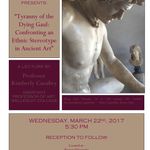
Wednesday, March 22, 2017, 5:30 pm
Professor Kimberly Cassibry, Wellesley College
“Tyranny of the Dying Gaul: Confronting an Ethnic Stereotype in Ancient Art.”
Location: 725 Commonwealth Ave., Room 303A
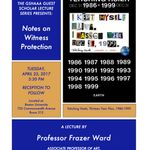
Tuesday, April 25, 2017, 5:30 pm
Dr. Frazer Ward, Smith College
“Notes on Witness Protection.”
Location: 725 Commonwealth Ave., Room 312
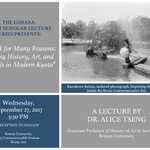
Wednesday, September 27, 2017, 5:30 pm
Dr. Alice Y. Tseng, Boston University
“A Park for Many Reasons: Herding History, Art, and Animals in Modern Kyoto”
Location: 725 Commonwealth Ave., Room 200
2015-2016
Sasha Goldman & Bryn Schockmel- Coordinators

Wednesday, September 23, 2015, 5:30 pm
Dr. Sophie Hochhäusl, Boston University
“From Siedlung to Suburb: Exhibiting the Austrian Prefabricated Home Epistemological Transfer, Americanization, and the U.S. Economic Mission in Vienna, 1952-1955″”
Location: 725 Commonwealth Ave., Room 200

Thursday, November 5, 2015, 5:30 pm
Dr. Peter Kalb
“Charting the Contemporary: On Writing Art Histories of the Present”
Location: 725 Commonwealth Ave., Room 303A
Tuesday, November 17, 2015, 5:30 pm
Dr. Lamia Balafrej
“Bihzad and the Artist’s Name in Persian Painting”
Location: 725 Commonwealth Ave., Room 200

Thursday, February 17, 2015, 5:30 PM
Dr. Danielle Carrabino, Associate Research Curator of European Art at the Harvard Art Museums
“Caravaggio’s Raising of Lazarus: the Lazzari, the Crociferi and the Hope of Salvation”
Location: 725 Commonwealth Ave., Room 303A
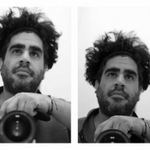 Wednesday, March 16, 2016, 5:30 pm
Wednesday, March 16, 2016, 5:30 pm
Dr. Jose Falconi, Post-Doctoral Fellow at Harvard University
“Reality (Always) Lies Elsewhere: Lessons from Anibal Lopez’s Documenta 13 “Testimonio””
Location: 725 Commonwealth Ave., Room 303A

Thursday, April 14, 2016, 5:30 pm
Dr. Jody Gordon of Wentworth Institute of Technology
“Insularity, Imperialism, and Identity: Contextualizing the Art of Roman Cyprus”
Location: 725 Commonwealth Ave., Room 303A

Wednesday, April 20, 2016, 5:30 pm
Dr. Ross Barrett, Boston University
“Perilous Prospects: Martin Johnson Heade’s “On the San Sebastian River” and the Florida Land Boom”
Location: 725 Commonwealth Ave., Room 303A
2014-2015
Tina Barouti & Kelsey Gustin- Coordinators
Tuesday, October 14, 2014, 5:30 PM
Dr. Carrie Anderson, Middlebury College
“The Challenges of Spatial Research: Johan Maurits and the Landscape of Diplomacy”
Location: 725 Commonwealth Ave., Room 200
Thursday, October 30, 2014, 5:30 PM
Laura Auricchio, The New School
“The Marquis: Lafayette Reconsidered”
Location: 725 Commonwealth Ave., Room 200
Thursday, February 5, 2015, 5:30 PM
Dr. Eva Troelenberg, Kunsthistoriches Institute, Florence
“East of Jordan to East Berlin: The Early Islamic Desert Castle Mshatta and its Cross-Cultural Modern Biography.”
Location: 725 Commonwealth Ave., Room 200
Wednesday, February 18, 2015, 5:30 PM
Dr. Amanda Gilvin, Mount Holyoke College and Smith College
“Eating Forward: Art and Politics During Niger’s Uranium Boom”
Location: 725 Commonwealth Ave., Room 200
Wednesday, April 8, 2015, 5:30 PM
Professor Daniel Bluestone, Boston University
“Iconic and Vernacular: Charlottesville’s Landscape of Prostitution, 1880-1950.”
Location: 725 Commonwealth Ave., Room 424
2013-2014
Jordan Karney and Michael Pagan- Coordinators
Wednesday, September 25, 2013, 5:30PM
Ana-María Reyes, Boston University
“Antigonismos: Metaphoric Burial as Political Intervention in Contemporary Colombian Art”
Location: 725 Commonwealth Ave., Room 303A
Thursday, October 10, 2013, 5:30PM
Kristen Gresh, Estrellita & Yousuf Karsh, Assistant Curator of Photographs,
Museum of Fine Arts, Boston Boston
“She Who Tells a Story: Women Photographers from Iran and the Arab World”
Lecture and Gallery Tour
Location: Museum of Fine Arts, 465 Huntington Ave., Henry and Lois Foster Gallery (Gallery 158)
Wednesday, November 20, 2013, 5:30PM
Christopher Bedford, Henry and Lois Foster Director, The Rose Art Museum, Brandeis University
Topic: TDB
Location: 725 Commonwealth Ave., Room 303A
Thursday, February 6, 2014, 5:30PM
Martha Buskirk, Montserrat College of Art
“Collision Course? Artists’ Rights versus Public Interest”
Location: 725 Commonwealth Ave., Room 303A
Thursday, March 18, 2014, 5:30PM
Celeste-Marie Bernier, University of Nottingham
“Imaging Resistance: Representing the Body, Memory and History in African American and Black British Visual Arts”
Location: 725 Commonwealth Ave., Room 303A
Thursday, April 10, 2014, 5:30PM
Title: “Views from the North: Photographs, Generations and Cultural Memory among the Inuit”
Location: 725 Commonwealth Ave., Room 303A
Thursday, April 17, 2014, 5:30PM
“Teaching the History of Art & Architecture with Google Earth”
Location: 725 Commonwealth Ave., Room 303A
2012-2013
Jeff De Blois, Elisa Germán, and Erin McKellar- Coordinators
Wednesday, September 19, 2012, 5:30PM
S. Rebecca Martin, Boston University
“Who was ‘Doros’? Hellenic Imagery, Phoenician Identity, and Roman Soldiers in the Middle Ground”
Location: 725 Commonwealth Ave., Room 303A
Wednesday, November 14, 2012, 5:30PM
Ben Weiss, Leonard A. Lauder Curator of Visual Culture, Museum of Fine Arts, Boston
“The Postcard Age: Postcards and History at an Art Museum”
Location: Museum of Fine Arts, 465 Huntington Ave., Morse Study Room
Enter via the MFA’s Huntington Avenue entrance. The Morse Study Room is located on the first floor of the Museum, near the Lower Rotunda. Please ring the doorbell to gain entry.
Note: This event will include a lecture at 5:30PM followed by an informal walkthrough in the Torf Gallery at about 6:15PM.
Please RSVP to emckel@bu.edu if you wish to attend the lecture portion, as space is limited to 25 attendees. Space is not limited for the gallery portion.
Monday, December 3, 2012, 5:30PM
Celeste-Marie Bernier, University of Nottingham
“Imaging Slavery”
Location: 725 Commonwealth Ave., Room 303A
Thursday, January 24, 2013, 6:00PM
Judith Bookbinder, Boston College
“Civil War Drawings: Artifacts and Art”
Location: 725 Commonwealth Ave., Room 303A
Thursday, February 28, 2013, 5:30PM
Sonja Duempelmann, Harvard Graduate School of Design
“Flights of Imagination: Powered Aviation and the Art and Science of Landscape Design and Planning”
Location: 725 Commonwealth Ave., Room 303A
Wednesday, April 10, 2013, 5:30PM
Professor Pamela Karimi, Assistant Professor of Art History. UMASS Dartmouth
Topic: A History of Modern Iran in Ten Objects
Location: 725 Commonwealth Ave., Room 303A
Wednesday, April 17, 2013, 5:30PM
Nancy Stieber, University of Massachusetts Boston
“Narrating History and Urban Identity: Amsterdam’s Visual Representation around 1900”
Location: 725 Commonwealth Ave., Room 303A
2011-2012
Lynne Cooney and Naomi Slipp, Coordinators
Wednesday, September 14, 2011, 5:30PM
Keith Morgan, Boston University
“Managing the Model Suburb: Professionalism, Class, Ethnicity, and the Making of Brookline, Massachusetts”
Location: 725 Commonwealth Ave., Room 200
Thursday, September 28, 2011, 5:30PM
Kate MacNamara
Directory, Boston University Art Gallery
Location: 725 Commonwealth Ave., Room 200
Wednesday, November 9, 2011, 5:30PM
Rosamond Purcell
“Things are Not as They Seem: A Lecture In Honor of Robert Seydel”
Practicing Artist
Location: 725 Commonwealth Ave., Room CAS 303a
Wednesday, November 16, 2011, 5:30PM
Michael K. Komanecky
“Picturing Ramona: Illustrations to Helen Hunt Jackson’s Novel of California”
Farnsworth Art Museum
Location: 725 Commonwealth Ave., Room CAS 303a
Wednesday, November 30, 2011, 5:30PM
Pieranna Cavalchini,
Isabella Stewart Gardner Museum
Location: 725 Commonwealth Ave., Room CAS 200
Wednesday, March 21, 2012, 5:30PM
Peter Probst
Tufts University
Location: 725 Commonwealth Ave., Room CAS 303a
Wednesday, April 11, 2012, 5:30PM
Sura Levine
Hampshire College
Location: 725 Commonwealth Ave., Room CAS 303a
Thursday, April 26, 2012, 5:30PM
Ross Barrett
University of North Carolina, Chapel Hill
Location: 725 Commonwealth Ave., Room CAS 303A
2010-2011
Jackie Canevari & Rachel Tolano, Coordinators
Thursday, September 30, 2010, 5:30PM
Deborah Kahn
Associate Professor, Boston University
“Demons in the Romanesque: A Case Study”
Location: 725 Commonwealth Ave., Room 200
Thursday, October 28, 2010, 5:30PM
Erica Hirshler
Croll Senior Curator of American Paintings, MFA
“Sargent’s Daughters: A Biography of a Painting”
Location: 725 Commonwealth Ave., Room 200
Friday, November 19, 2010, 5:30PM
Mario Ontiveros
Assistant Professor, UMass
“Semi-Solid: Impermanence, Uncertainty, and Chicana/o Aesthetics”
Location: 725 Commonwealth Ave., Room CAS 132
Wednesday, December 8, 2010, 6:00PM
Michele Cohen
Assistant Professor, Simmons
Director, Trustman Art Gallery
“Public Art for Public Schools”
Location: 725 Commonwealth Ave., Room 303A
Wednesday, January 26, 2011, 5:30PM
Adriana Zavala
Tufts University
“Becoming Modern Becoming Tradition”
Location: 725 Commonwealth Ave., Room 200
Monday, February 14, 2011, 5:30PM
Pamela Allara
Brandeis University
“Repositioning: White South African Artists in the ‘New’ South Africa”
Location: 725 Commonwealth Ave., Room 200
Thursday, March 24, 2011, 5:30PM
Francesca Bewer
Harvard Art Museum
“Harvard’s Fogg Museum and the Emergence of Art Conservation in America
(CA. 1900-1950)”
Location: 725 Commonwealth Ave., Room 200
Thursday, March 31, 2011, 5:30PM
Caroline Bruzelius
Duke University
“What Can Digital Visualization Do For the Humanities
(and Especially Art History)?”
Location: 725 Commonwealth Ave., Room 200
Tuesday, April 5, 2011, 5:30PM
Judy Ditner
Boston University
“10,000 Lives, The 8th Gwangju Biennale”
Location: 725 Commonwealth Ave., Room 200
Thursday, April 21, 2011, 5:30PM
David Haney
University of Kent/CREAte
“LeBrecht Megge and the Problem of Modern vs. Conservative in Early 20th Century Landscape Architecture”
Location: 725 Commonwealth Ave., Room 200
2009-2010
Sarah Parrish & Hannah Blunt, Coordinators
Thursday, September 24, 2009, 5:30PM
Talinn Grigor
Assistant Professor, Brandeis University
“Backward-Looking Modernists: British-Indian Origins of the Persian Style”
Location: 725 Commonwealth Ave., Room 200
Wednesday, October 21, 2009, 5:30PM
Hilda Westervelt
Assistant Professor of Art History, Boston University
“Women’s Work: The Threat of Female Toil in Greek Art and Myth”
Location: 725 Commonwealth Ave., Room 200
Tuesday, November 10, 2009, 5:30PM
Sharon Corwin
Carolyn Muzzy Director and Chief Curator,
Colby College Museum of Art
“Constructed Documentary: Margaret Bourke-White from the Steel Mill to the South”
Location: 725 Commonwealth Ave., Room 200
Wednesday, November 18, 2009, 5:30PM
Adriana Zavala
Associate Professor, Tufts University
“Intimate Encounters: Mexican Modernism and the Female Nude”
Location: 725 Commonwealth Ave., Room 200
Wednesday, December 2, 2009, 5:30PM
Helen Burnham
Assistant Curator of Prints and Drawings, Museum of Fine Arts, Boston
“Albrecht Dürer at the MFA”
Meet in the Scharf Visitor’s Center at the MFA at 5:30 p.m.; our group will be escorted to the exhibition for a private tour and lecture. Admission is free on Wednesdays after 4:00 p.m
Thursday, JANUARY 21, 2010, 5:30PM
Véronique Plesch
Professor of Art, Colby College
“Early Modern Graffiti on Religious Frescoes: Vandalism or Piety?”
Location: 725 Commonwealth Ave., Room 303A
Thursday, FEBRUARY 11, 2010, 5:30PM
Nick Capasso
Senior Curator, DeCordova Sculpture Park + Museum
“How to Spend $1 Million on Contemporary Sculpture”
Location: 725 Commonwealth Ave., Room 303A
Thursday, FEBRUARY 25, 2010, 5:30PM
Dietrich Neumann
Professor of History of Art and Architecture, Brown University
“A Skyscraper for Mussolini: Mario Palanti and Urban Planning for Rome in the 1920s”
Location: 725 Commonwealth Ave., Room 303A
Thursday, MARCH 25, 2010, 5:30PM
Jodi Cranston
Associate Professor, Boston University
“Close Looking in Titian’s Later Paintings”
Location: 725 Commonwealth Ave., Room 303A
Thursday, APRIL, 2010, 5:30PM
Nancy Berliner
Curator of Chinese Art, Peabody Essex Museum
“Hidden Treasures from the Forbidden City, The Emperor’s Private Paradise”
Location: 725 Commonwealth Ave., Room 303A
2008-2009
Lili Mugnier, Coordinator
Thursday, September 18, 2008, 5:30PM
Alan Chong, Curator of the Collection, Isabella Stewart Gardner Museum
” A Conversation with Alan Chong, Conceptualizing Exhibitions at the Isabella Stewart Gardner Museum”
Location: 725 Commonwealth Ave., Room 200
Thursday, October 16, 2008, 5:30PM
Lawrence Berman, Norma Jean Calderwood Senior Curator of Ancient Egyptian, Nubian, and Near Eastern Art, Museum of Fine Arts, Boston
“Inside Art & Empire: A Look at Treasures from Assyria in the British Museum”
Location: 725 Commonwealth Ave., Room 200
Thursday, November 6, 2008, 5:30PM
Gregory Williams, Assistant Professor, Boston University
“Jokes, Wit and Political Agency in West German Art, 1961-1989”
Location: 725 Commonwealth Ave., Room 200
Thursday, November 20, 2008, 5:30PM
Peter Kalb, Assistant Professor, Brandeis University
“The Sensations of Televisuality: Tom Sachs Logjam as Case Study”
Location: 725 Commonwealth Ave., Room 200
Thursday, January 29, 2009, 5:30PM
Tony Sigel, Conservator of Objects and Sculpture, Strauss Center for Conservation, Harvard Art Museum
“Gian Lorenzo Bernini’s Terracotta Sculpture: Conception, Execution, Authorship, Conservation”
Location: 725 Commonwealth Ave., Room 200
Thursday, March 26, 2009, 5:30PM
Stephen Perkinson, Associate Professor, Bowdoin College
“About Face: The Prehistory of Portraiture in Medieval France”
Location: 725 Commonwealth Ave., Room 303
Thursday, April 2, 2009, 5:30PM
Mercedes Volait, Director of the Centre National de la Recherche Scientifique, Director of INVISU, Institut National d’Histoire de l’Art, Paris
“Other Modernisms: Architecture in Egypt 1870s-1940s”
Location: 725 Commonwealth Ave., Room 200
Thursday, April 16, 2009, 5:30PM
Cynthia Becker, Associate Professor, Boston University
“Art, Self-Censorship, and Public Discourse: Contemporary Moroccan Artists at the Crossroads”
Location: 725 Commonwealth Ave., Room 200
Each Guest Lecture lasts approximately one hour and is followed by a brief Q&A session and a reception.
2017-2018
Lana Sloutsky & Sandrine Lacorie, Coordinators
Tuesday, September 18, 2007, 5:30PM
John M. Russell, Professor of Art History, Massachusetts College of Art
“The Current State of Cultural Heritage in Iraq.”
Location: 725 Commonwealth Ave., Room 200
Thursday, October 25, 2007, 5:30PM
Shirin Fozi, Ph.D. Candidate in History of Art & Architecture, Harvard University
“A Mere Patch of Color: The Shattered Glass of Rheims Cathedral.”
Location: 725 Commonwealth Ave., Room 200
Wednesday, November 7, 2007, 5:30PM
Emine Fetvaci, Assistant Professor of Islamic Art, Boston University
“The Prince and the Eunuch: An Account of the Ottoman Imperial Circumcision Festival of 1582.”
Location: 725 Commonwealth Ave., Room 200
Tuesday, December 4, 2007, 5:30PM
Tracey Albainy, Senior Curator of Decorative Arts and Sculpture at the Museum of Fine Arts, Boston
“Symbols of Power: Napoleon and the Art of the Empire Style, 1800-1815.”
Location: 725 Commonwealth Ave., Room 200
Thursday, January 31st, 5:30PM
Paolo Scrivano, Assistant Professor of Art History, Boston University
“Those Kitchens We Cannot Have’: Dreams of America in Italy’s Postwar Household Environment.”
Location: 725 Commonwealth Ave., Room 200
Thursday, February 28th, 5:30PM
Monica McTighe, Assistant Professor of Contemporary Art, Tufts University
“Retro Visions: Nostalgia in Recent Video Installations.”
Location: 775 Commonwealth Avenue, the George Sherman Union, Room 310
Tuesday, March 18th, 5:30PM
Ronni Baer, Mrs. Russell W. Baker Secior Curator of Paintings, Art of Europe, Museum of Fine Arts, Boston
“Curating, “El Greco to Velazquez: Art During the Reign of Phillip III” exhibit at the Museum of Fine Arts.”
Location: 725 Commonwealth Ave., Room 200
Thursday, April 10, 5:30PM
Elizabeth ten Grotenhuis, Professor Emerita of Japanese Art History, Boston University
“Blue and White Ceramics: A Silk Road Story.”
Location: 725 Commonwealth Ave., Room 200
Thursday, May 1, 5:30PM
Alice Tseng, Assistant Professor of Japanese Art and Architecture, Boston University
“A Meditation of Interpretive Methods for Architectural History, or ‘How to Talk About Buildings You Haven’t Seen.”
Location: 725 Commonwealth Ave., Room 200
2006-2007
Ben Charland, Coordinator
Thursday, September 28, 2006, 5:30 pm
Gianfranco Pocobene, Chief Conservator of Paintings, Isabella Stewart Gardner Museum
“Conserving the John La Farge Murals of Trinity Church”
Thursday, October 5, 2006, 5:30 pm
Catherine D’Ignazio, Associate Professor of New Media, Rhode Island School of Design
“On the Wisdom of Infinitely Small Things?”
Wednesday, November 1, 2006, 5:30 pm
Patricia Johnston, Professor of Art History, Salem State University
“Seeing High & Low: The Impact of the Visual Culture Movement on the History of American Art”
Tuesday, November 28, 2006, 5:30pm
Jonathan Unglaub, Assistant Professor of Fine Arts, Brandeis University
“Painting as Parthenogenesis: Raphael’s Sistine Madonna”
Thursday, February 1, 2007, 5:30 pm
Susan Dackerman, Curator of Prints, Fogg Art Museum
“Dissent! Protest Art on Paper”
Thursday, February 22, 2007, 5:30 pm
Eric Rosenberg, Professor of Art History, Tufts University
“Walker Evans’s Depression and the Trauma of Photography”
Thursday, March 29, 2007, 5:30 pm
Bill Arning, Curator, The MIT List Visual Arts Center
“Sensorium: Embodied Experience, Technology, and Contemporary Art”
Tuesday, April 24, 2007, 5:30 pm
Alan Braddock, Assistant Professor, American Art and Visual Culture, Syracuse University
“Thomas Eakins and the Cultures of Modernity”
2005-2006
Lisa Sutcliffe, Coordinator
- 10/6: Ralph Helmick and Stuart Schechter, public sculptors, “Public Art: Sell Out? or the Last True Path for the Citizen Artist?”
- 11/2: Georgia Barnhill, Andrew W. Mellon Curator of Graphic Arts American Antiquarian Society, “‘With a French Accent’–American Lithography, 1820-1860.”
- 11/10 at 5:15pm: Karen Kramer, Assistant Curator of Native American Art Peabody Essex Museum, on her show “All of My Life: Contemporary Works by Native American Artists.”
- 12/1 at 5:15:John Stomberg, Associate Director for Administration and Programs Williams College Museum of Art, “Suffering and Style in 1930s American Photography.”
- 2/16:David Kim, doctoral student, Harvard University “Gentile Bellini: Artist and Ambassador”
- 03/01: Natasha Khandekar, Co-director, Art Interactive “Looking Closely: Using Physical Evidence in Art History”
- 03/01: Natasha Khandekar, Co-director, Art Interactive “Looking Closely: Using Physical Evidence in Art History”
- 04/10: Joanne Lukitsh, Professor, Massachusetts College of Art “Alone on the Sidewalks of New York: Alfred Stieglitz’s Photography, 1892-1913″ This talk is based on a chapter in an anthology,”Seeing High and Low Representing Social Conflict in American Visual Culture,” edited by Patricia Johnston.
- 04/10: Joanne Lukitsh, Professor, Massachusetts College of Art “Alone on the Sidewalks of New York: Alfred Stieglitz’s Photography, 1892-1913″ This talk is based on a chapter in an anthology,”Seeing High and Low Representing Social Conflict in American Visual Culture,” edited by Patricia Johnston.
- 04/27: Anna Stanfield, Ohr-O’Keeffe Museum, Biloxi, AL “Learning from Katrina: The Future of Disaster Planning in American Museums”
2004-2005
Carrie Moore, Coordinator
- Keith Morgan, Art History Professor, Walking Tour of Trinity Church
- Natasha Seaman, Boston University PhD Candidate, ‘Embedded Devotion in Hendrick ter Bruggen’s Crowning with Thorns’
- Leslie Brown, Curator at the Photographic Resource Center, will discuss the upcoming ‘Contemporary Vernacular’ show at the PRC and give an introduction to the library.
- Chris Atkins, Research Assistant, Arts of Europe, MFA Boston, ‘Not So Fast: A Reconsideration of Frans Hals’s ‘Rough Manner’
- Christine Poggi, Associate Professor at the University of Pennsylvania, will present ‘Representing Madness in 1905: Giacomo Balla’s ‘The Madwoman’ and the Cycle ‘The Living’
- David Dearinger, Susan Morse Hilles Curator of Paintings and Sculpture, Boston Athenaeum, ’19th Century American Neo-classic Sculpture and the City of Boston’
- May Stevens, Artist, in conjunction with Professor Pat Hills ‘Art and Politics’ class
- Arthur Beale, Head of Conservation, MFA, ‘Defining Authenticity’
- Lizzi Ross, Public Programs Manager, ICA, “Public Programming at the ICA.”
- Hilda Westervelt, Assistant Professor of Art History, Boston University. “Kainis’ Choice: Avoidance of Marriage and Motherhood and its Consequences in Greek Myth”
- Screening of Allan Shinohara’s documentary about migrant Jamaican tobacco workers in western Massachusetts.
2003-2004
Melissa Renn, Coordinator
- Dr Michael Stone-Richards, Visiting Professor in English Comparative Literature, Stonehill College, and Graham Foundation Scholar: Implantation and Affective Spaciality: Guy Debord with Daniel Libeskind
- Bet McLeod, Assistant Curator of Decorative Arts and Sculpture, Department of the Art of Europe, Museum of Fine Arts, Boston will speak on the newly-installed 19th century gallery at the MFA and on issues of display, access, interpretation and the new directions the Museum is exploring for its new wing.
- Anna Konivets, Coordinator of the Hermitage/Guggenheim Museum collaboration will speak on the Russian Festival/Education Bridge Project.
- Anthony Lee, Professor, Department of Art History, Mount Holyoke College: ‘When the Cobbling Began: Photography and Chinese Shoemakers in a 19th century New England Factory Town.’
- Jonathan P. Ribner, Associate Professor, Art History Department, Boston University. Danger Across the Water:’ Professor Ribner’s Recent Research
- Jonathan M. Bloom, Norma Jean Calderwood University Professor of Islamic and Asian Art, Boston College. Paper Before Print: The Introduction of a New Medium and its Impact on the Arts of the Islamic Lands.
- Margaret Laster (formerly of the MFA) on Nazi-era provenance research issues.
- Bonnie Costello, Professor of English, Boston University, ‘Planets on Tables: Poetry and Still Life’
- Wanda Corn, Professor, Art History Department, Stanford University and Radcliffe Fellow, Harvard University, will speak on Georgia O’Keeffe and Seriality
- Jessica Sewell, Assistant Professor, Art History Department and American and New England Studies Program, Boston University. ‘Eclipsing the Boston Tea Party: Suffrage and Tea, the Equality Beverage.’
2002-2003
Kate Palmer, Coordinator
- Keith Morgan, Professor of Art History at Boston University. Walking tour of Boston’s Kenmore and Fenway areas
- Ulrich Lehmann. ‘Fetish of the Female: George Sand and Gavarni’
- Karen Lucic, Professor of Art at Vassar College. ‘The Photography of Charles Sheeler: American Modernist’
- Michelle Lamunire, PhD Candidate in Art History, Boston University. ‘You Look Beautiful Like That: The Portrait Photographs of Seydou Keita and Malick Sidibe’
- Keith Doherty, PhD Candidate in Art History, Boston University. ‘Recent Discovery in the Athenian Agora’
- Nick Capasso, Curator, DeCordova Museum and Sculpture Park. ‘Painting in Boston, 1950 – 2000: A Curatorial Case Study’
- Alexandra Schwartz, PhD Candidate, University of Michigan. ‘Learning from Los Angeles: Ruscha, Venturi, and Scott Brown’
